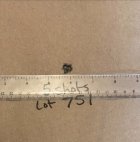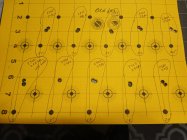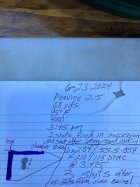Well, his explanation of a terrible tune is over 0.25" groups at 100y with a known good load. My lowest X count days at 1000y have been on days leading up to a big storm, or those mid summer rains that roll through and pressure drops. I generally shoot at sea level to 1500' ASL.
Let me explain what I mean if I may, because many guys are going to suggest I need to
"tune for the conditions"
This is a fun but somewhat lengthy back story so I'll try to not derail the thread too much except to say
I originally developed this load at Approx 2000' El at about 60F
Months later I went to a location of approx 4000' and 100F in July Summer Heat.
It was HOTTT, sweat dripping into your eyes from just Standing still, constantly wiping your forehead.
Up near Union Valley Res
A buddy had his Tikka Tac A1 in 6.5 Creed and we're going to load test for the extremes of heat
I suggested we run a Hot weather test on our ammo to gauge vertical dispersion.
...(shown for this test is a 3 shot test group in lower left of pic)
One thing I may do differently than other guys is I Test and Tune my loads for the maximum amount of Heat I may ever encounter while shooting
That way I never have an overpresure
Even if I develop a load at 40F I will test it at 100F to ensure it does not overpressure when it gets hotter outside
Then cut it back accordingly
--------------------------------------
So we go prone and set up because I want to see how much vertical I may get as the round heats up
So I ask my buddy to Spot
I fire 2 shots consecutively one right after the other for a test group
Ensure it is on, all shots are going in the same place
upon firing the second shot I said "good, same hole"
He asks, "Well how do know it was in the same hole,.....if it went in the same hole how do you see it?"
(He's kinda new to this stuff so I am helping him learn)
I kind of laughed and said "Well, first because no other holes printed around it and second because when they go into the same hole it looks like the hole "wiggles"
He just kind of looked at me weird like he didn't believe me
So I chamber a 3rd round and close the bolt and let it "cook" in the chamber for 10 minutes in 100F heat.
Then I ask him to spot when the time came and fired
He lowered his head and mumbled "SAME ..............HOLE"
------------------
So when my shots are printing like this, from one atmospoheric extreme to the next
I mean shot 3 did go Barely a hair higher from the heat of cooking in the chamber for 10 minutes but...
...I don't see why I would adjust anything?
Is it because other people are using slower cartridges that are below 3000 fps they encounter this more pronounced having to tune to the conditions?














